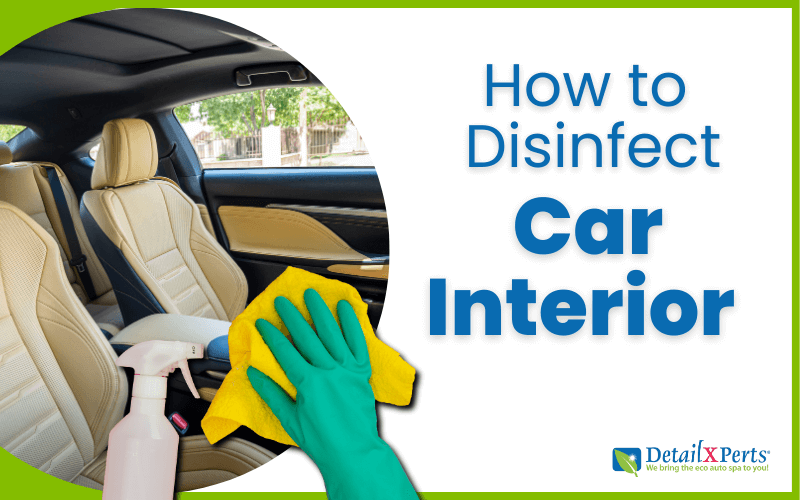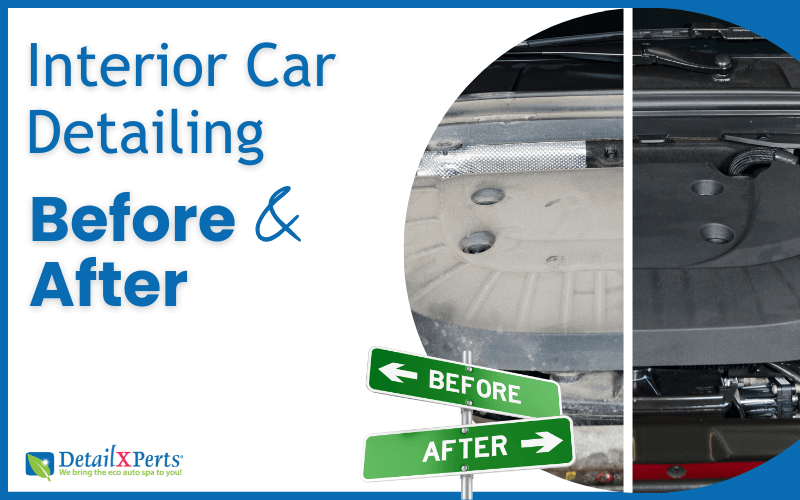It is important to know how to disinfect car interior if you want to eliminate bacteria, viruses, and other pathogens. The inside of your vehicle might look clean, but surfaces and high-touch surfaces such as the controls, door handles, and the steering wheel can be a hotbed for germs. That’s why we recommend adding regular vehicle sanitization steps to your car interior detailing routine.
Disinfect Car Interior – 10 Steps and Procedures
The best way to detail a car interior combines cleaning and disinfecting. For example, cleaning focuses on removing dirt and dust, while disinfecting your car interior typically involves using an auto interior disinfectant or one of the best car interior detailing products designed to kill germs. Also, steam cleaning is perfect for car sanitization. Here are the steps and procedures:
1. Collect Your Detailing Tools
Gather the items you’ll need. Your car interior detailing kit for cleaning and vehicle sanitization should contain the following items:
- Steam cleaner for cars
- Vacuum cleaner and attachments
- Microfiber car cloths for car interior
- A range of car detailing brushes
- Car shampoo
- Auto interior disinfectant, such as antibacterial spray or wipes
- Protective gloves
Tip: You can use store-bought auto wipes (containing at least 70% isopropyl alcohol) or make your own disinfecting solution with 70% isopropyl alcohol and water (1:1 ratio).
2. Choose Suitable Disinfectant Products
Common disinfectants used for car interiors include hydrogen peroxide and isopropyl alcohol (also known as rubbing alcohol). For example, you can use isopropyl alcohol to disinfect high touch surfaces like door handles, steering wheel, and controls to kill viruses, bacteria, and harmful pathogens. Some points to bear in mind:
- Always read the instructions if you use a disinfecting solution or spray. I.e., check it won’t damage hard surfaces, upholstery, and carpets. Test disinfectants on a small, hidden area to ensure they won’t cause damage or discoloration.
- Avoid using bleach and abrasive cleaners on delicate materials and surfaces. Equally important, don’t use ammonia-based cleaners. They can be damaging to materials commonly found in car interiors, such as plastics, vinyl, and leather.
- Ideally, the disinfectant shouldn’t have a strong odor (yet another reason to avoid ammonia-based cleaners). A build-up of toxic fumes inside your car is not safe or pleasant for you or your passengers.
Another option is to seek out a professional car interior detailing service. DetailXPerts knows how to disinfect car interior safely and efficiently using steam technology. Not only does this method kill germs, but it also shows care and responsibility towards the environment.
Tip: Seek out eco-friendly products that are non-toxic but tough on germs. For example, DetailXPerts uses EPA-certified disinfectants combined with steam cleaning procedures to kill harmful pathogens in a car interior. Another tip – if you decide to schedule a car sanitizing service, see our guide on how much does interior car detailing cost.
3. Vacuum Car Interior
Park your vehicle in a well-ventilated area and open the doors and windows for better air circulation. Start by making sure seats and surfaces are clutter-free before you disinfect your car. Then, vacuum the upholstery, carpets, and floor mats to ensure the interior is spotless.
Pay special attention to the car seats. Crumbs, hair, and dust can settle in crevices, such as the seat-stitching grooves in the upholstery.
Choosing the best car vacuum with a range of tool attachments makes your job much easier. Some tools are specifically designed for upholstery, while others let you access crevices and those hard-to-reach places. Once the vacuuming is done, you can begin to disinfect your car interior.
Tips: Remember all the places to clean the inside of your car. Pull the seats forward to access the area underneath. Don’t forget about the armrest between the driver and passenger, storage areas, and the rear center console if there is one.
4. Clean and Disinfect Car Seats
Our car seats tend to catch most of the dirt, crumbs, and other spillages during car journeys. Therefore, it is a good idea to disinfect car seats every couple of weeks or when you spot dirt or a stain on the upholstery. Here is how to achieve a sanitized clean.
Get Rid of Stains
Inspect the car seats for any stains, especially if your regular passengers are children or pets. Stubborn, dirty marks on seats from footwear, drink spillages, greasy marks, grass stains and so on can spoil the appearance of your car seats. Knowing best how to remove stains from car seats will also ensure you don’t damage the fabric or leather upholstery in your vehicle.
Shampoo Seats
The next step is to shampoo and deep clean car seats to refresh upholstery. Take care not to transfer germs from a dirty cloth onto a clean seat. The best practice is to color code cleaning and drying cloths for specific tasks, just like the professionals, to avoid cross-contamination.
Avoid using excessive moisture on fabric seats, as this can lead to mold or mildew growth. If this becomes a problem, see how to remove mold from car interior.
Note, using just soap and water is not enough to disinfect your car seats. Therefore, you need to take an additional step to ensure car sanitization for the health of the driver and passengers. See below.
Apply Your Chosen Disinfectant
Use disinfectant wipes or spray your auto interior disinfectant onto the car seats. Most disinfectants require a specific time (dwell time) to kill germs effectively. Follow the instructions on how long to leave the disinfectant on the seat. For example, it is usually around 1-5 minutes.
After sanitizing the seats, use a disinfecting wipe or a microfiber cloth dampened with your homemade disinfectant to clean your other surfaces.
Tip: If you prefer to keep it green, you can steam clean car seats without using any disinfectants at all. To be on the safe side, wear heat-resistant safety gloves. See how to do it below.
5. How to Disinfect Car Interior Using a Steam Cleaner
Take a moment to familiarize yourself with how to use a steam cleaner for cars. It is a pretty straightforward piece of equipment. However, bear in mind that you will be working with hot vapor in a confined space when steam cleaning and sanitizing your car.
Always direct the attachments towards the car’s interior surfaces, upholstery, and carpets to avoid steam burns on your hands or face. Once you’re ready to steam clean car interior, work from top to bottom. Pay special attention to these high touch surfaces:
- Power button/ignition switch
- Steering wheel and controls
- Seat belts
- Interior door handles
- Window controls
- Dashboard and vents
- Visors and rearview mirror
- Gear shift
- Children’s car seats
Always have a dry microfiber cloth to hand to wipe away any dislodged dirt and grime while you work, especially if you plan to steam clean car seats. The heat of the steam is very effective at removing stubborn stains and ground-in dirt from different interior fabrics and materials, such as polyester, suede, leather and faux leather.
Tip: Watch our video to see how to disinfect car interior using steam.
.6. Disinfect Seat Belts and Head Restraints
We touch our seat belts at the start and finish of every car journey. Therefore, the belt fabric quickly picks up dirt and grease. This is a breeding ground for germs and bacteria. Head restraints also pick up dirt and oils from people’s hair.
Hot steam is powerful enough to kill bacteria on seat belts and head restraints without damaging the fabric. Furthermore, the steam treatment dries quickly, so you don’t have to worry about damp seatbelts/head restraint resting against your clothing or head if you drive later that day.
Tip: Spot-treat any stains on seatbelts and use a soft brush to agitate and lift out dirt. Then wipe clean with a dry microfiber cloth.
7. Disinfecting AC Vents
Knowing how to clean your car AC vents correctly helps reduce the risk of airborne germs and bacteria. First, use an appropriate car wash brush type to dust the air vents. Then disinfect the vents.
Again, we recommend sanitizing with steam. Moreover, the Centers for Disease Control and Prevention (CDC) confirms that the high steam temperature kills microorganisms. It is also odorless. Therefore, it leaves a perfectly safe and comfortable environment for car journeys. Steam cleaning is also safer for people who may have respiratory problems.
Tip: Disinfecting air vents will eliminate odors. However, if you detect unpleasant odors from carpets or seats, see how to get bad smell out of car.
8. Disinfect Car Carpets
Remove car mats before disinfecting car carpets. If necessary, use a car carpet stain remover first. Spray a suitable disinfectant over the entire carpet area. Remember to clean the out-of-sight places, such as underneath pedals and seats.
Before putting the floor mats back, clean and disinfect them separately, as they catch a lot of dirt and other contaminants. This is an often-overlooked procedure.
Tip: It’s essential to allow your carpet to dry completely to prevent mold and mildew growth. If you’re concerned about drying time, contact us to arrange a car sanitizing service. One of our skilled technicians will steam clean your carpets. This method only uses minimal water, so carpets will dry quickly.
9. Finish With an Antibacterial Spray
Once you have finished cleaning and disinfecting your car interior, leave it to dry completely before the final step.
Finalize cleaning and sanitizing the car interior with a protective antibacterial spray. Choose a biodegradable all-surface spray that is suitable for fabric and leather upholstery. This will provide barrier protection to help stop bacterial growth and minimize the spread of germs between interior car detailing appointments.
Tip: Also apply a car interior cleaner and protectant to surfaces to prevent fading, cracking, and sun damage.
10. Ventilate the Car
After cleaning and disinfecting your car, leave the doors and windows open for a while. This will ensure proper ventilation and to help remove any residual disinfectant odors.
Tip: Aim to disinfect your car every 3 months if you use your car regularly. However, you may prefer to use antibacterial wipes even more frequently on your steering wheel, door handles and seatbelts, especially if you are concerned about hygiene.
Conclusion
Knowing how to disinfect car interior ensures a healthier space for you and your passengers. You can choose disinfectants, steam, or both to ensure you eliminate bacteria and germs from car surfaces.
However, working with a disinfectant that is safe for use in enclosed spaces and on car interior surfaces is important. Always follow the manufacturer’s instructions and safety guidelines for the chosen disinfectant. An even better choice is to use steam and eco-friendly disinfectants.
Steam cleaning is the greenest way to disinfect your car interior. Moreover, it can reach into those awkward spaces that a cloth may miss.








